A Daily Quest for Water in a City Running Dry
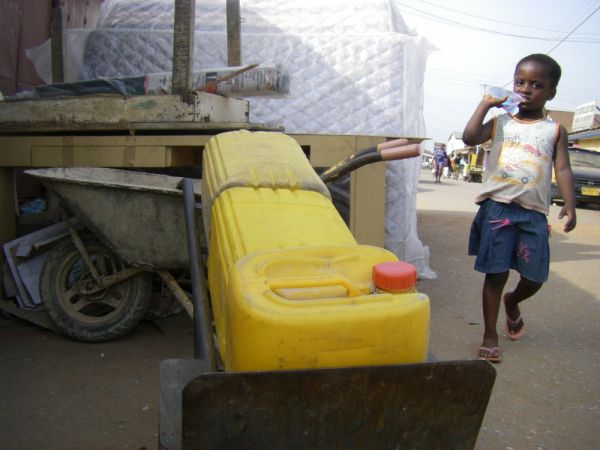
In Accra, water is something most often found in a container, whether it be a Gallon, a Polytank or a single-serve sachet. Photo credit: Sharon Benzoni
Five Kufuor Gallons are stacked against the wall when I enter Auntie Mariam’s compound early one recent morning. The sun is barely up, but the courtyard is already buzzing with activity as her 19 family members prepare for their day. “Nineteen is the official count,” she says, “but I think there may be more.” She nods at several of her daughters, gathered nearby. “These girls will be going with you.” One of them looks at me and grins. “You can carry this one because it matches your color,” she says, pointing to the one white one among the lot of yellow plastic jerrycans. So I pick up my Gallon and off we go.
Mariam (confusingly, one of Auntie Mariam’s daughters) leads the way through the winding, narrow alleyways that make up Nima, a sprawling informal settlement in northern Accra. We are on a mission to find water, a mission these girls wake up to every day. I start my voice recorder, which will also serve to keep track of the time this mission takes. Someone yells out to Mariam. She laughs and tells me that they have joked that things must really be bad if a white woman is out fetching water.
“The Gallon is the white bread of Accra!” Salifu, my friend from the People’s Dialogue on Human Settlements laughed when I told him I was writing a story about the Kufuor Gallon, or just “the Gallon” for short. The Gallon is the yellow plastic jerrycan that begins its (usually long) life as a container for cooking oil before entering the informal economy as a container for water. It’s one of those ubiquitous things – like the loaves of white bread for sale by the roadside — so common it blends into the landscape, becoming invisible. But unlike many common objects, this one has a history and political meaning attached to it.
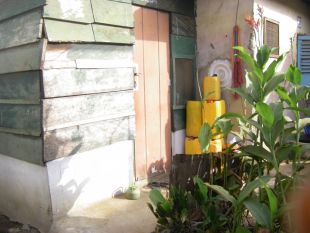
When you start looking for the Gallon in Accra, you suddenly notice it everywhere. Photo credit: Sharon Benzoni
When you start looking for the Gallon, you see it everywhere, a constant reminder of the tenuous state of Ghanaians’ access to basic needs. There are stacks of them against the outer walls of houses. Taxis and trucks with yellow gallons peeking out the back. As I came out onto the street the other day, two men with wheelbarrows were standing in front of my neighbor Abu’s house, carting two Gallons each. On my morning run, a girl carrying a Gallon in her hand told me that she would walk another half-kilometer to fetch water. The containers (which hold, despite their name, ten liters, or a little more than two-and-a-half gallons) were dubbed the “Kufuor Gallon” because of the water crises that marked the tenure of John Kufuor, Ghana’s president from 2001 to 2009, a crisis that continues to plague Accra.
People need the Gallon everywhere in Accra because government water provision, like that of electricity, is variable and unpredictable. The water can flow from taps for weeks at a time and then suddenly shut off. One solution, for those who can afford it, is to buy a Polytank, a large black plastic water storage cylinder. Mounted on a rooftop or its own concrete stand, a gravity-powered Polytank can provide flowing water. On the ground, usually on a concrete slab, it can be used to fill buckets and Gallons. But getting the water into the Polytank can be complicated: You can buy a pump to fill the tank when the water is flowing, but if it’s out for a long period of time, you may have to call a private water company to fill it. If you don’t have your own Polytank, you may have to buy or borrow water from a neighbor who does.
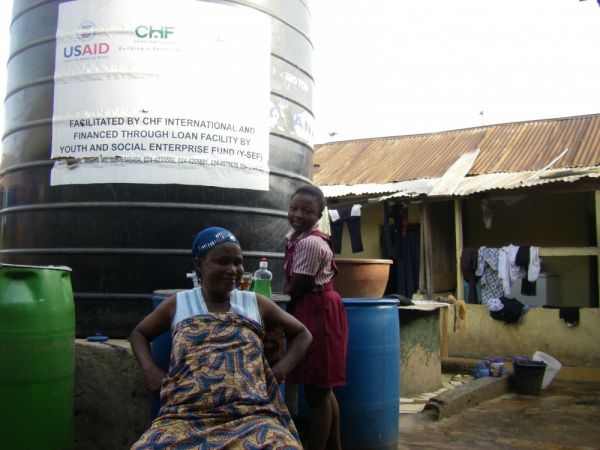
Mariam and her Polytank, bought with a loan from USAID. Photo credit: Sharon Benzoni
What it boils down to (no pun intended) is that everyone, whatever their class, has to patch together different ways to access water. In my own apartment, three Gallons sit beside my bathroom, and for a few days this week, I took bucket baths and flushed the toilet with water my landlord carted over in the back of his truck from God-knows-where. In East Legon – a wealthy neighborhood in the north of the city – as of this writing, taps had just begun flowing after weeks of no water. People came running to fill up all the containers they had; you never know when it will stop flowing and the search for water will again become an epic struggle.
In Nima, as in many low-income informal settlements, the problem of water is even more complicated. “Nima,” the younger Mariam told me, laughing, as we wound our way through narrow alleys crisscrossed by open drainage, “is only gutters.” Her evocative wording reflects her mother’s more straightforward statement of the issue: “We don’t have streets in this community.” And so even installing municipal water is a huge challenge. So is filling Polytanks; the big water trucks’ long hoses can’t reach the interior of the community. Mariam bought a Polytank some years ago with a loan from USAID, but her tap is connected to the municipal supply. She also has a borehole – again, built with a loan, this one from CHF — but the water from the well is salty and certainly not potable; it can only be used for washing clothes and bathing. Her household of nineteen (possibly more) uses five Gallons (50 liters) of water per day. Even this water’s drinkability is questionable. Most people drink purewater from sachets if they can afford the 10 pesewas (5 cents) each 500-milliliter packet costs. Water pressure from the municipal supply tends to be better at the main roads — too many people have tapped into the pipes far from the main lines.
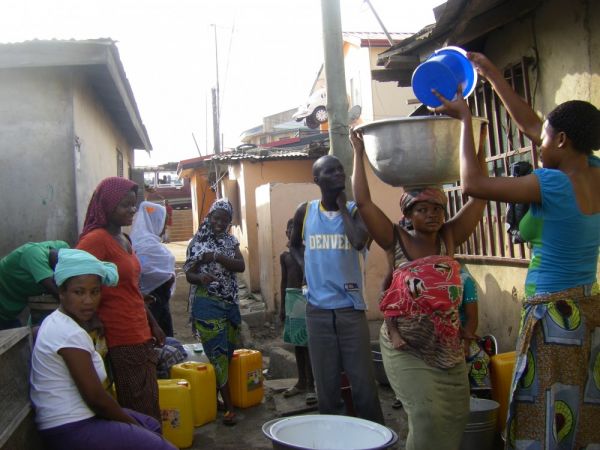
Hauling water long distances is part of many people’s daily routines in Accra. Photo credit: Sharon Benzoni
Serge Attukwei Clottey remembers the Kufuor Gallon from his childhood. “The yellow Gallon has inspired me for a long time,” he says. A native of La, a tiny, crowded indigenous Ga fishing community on Accra’s coast, he lives in a small family home there where he plans and creates art installations using the Gallon. As a child, he lived with an uncle who had a big fountain where everyone from the neighborhood came, with their Gallons in tow, to collect water. “Water stress was very high,” he told me. “People spent nights on the streets” waiting in line to collect water from any available source. Now, the Gallon has become his signature as an artist. In a recent public art installation for Ghana’s 56th anniversary, he created a wall of Gallons – representing the Akosombo Dam, the source of much of Ghana’s water supply – and painted the face of Ghana’s legendary first president, Kwame Nkrumah, on it. Nkrumah built the dam and, Clottey feels, his visionary plans for the country’s development have been betrayed by a corrupt and ineffective political system. Once, he dressed up in a suit and carried a Gallon reading “Are We Free?” into various institutions like banks and offices buildings, driving home the idea that everyone needs the Gallon. “I see the Gallon as part of our skin – every day we use the Gallon.”
Auntie Mariam has praise for the Gallon as a water container. “Using the gallon is hygienic,” she says. “If it’s clean, it’s the perfect tool.” The Gallon has a lid that keeps out dust and other contaminants, so storage isn’t an issue. An empty Gallon costs 2-4 cedis ($1-2 USD). To fill the Gallon at a local water vendor – from a Polytank or private tap with municipal water – costs between 30 pesewas (15 cents USD). For delivery, a Gallon can cost 1 cedi (50 cents USD) or more.
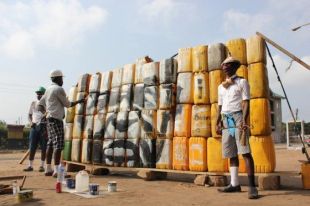
Serge Attukwei Clottey with one of his art installations. Photo credit: Sharon Benzoni
The younger Mariam, her sisters and I make five stops at Polytanks and municipal taps, winding our way through the narrow pathways of Nima before we finally find a place to fetch water. Several of the sources we try have run dry, at one the line is too long and at another the only water available is brackish. When we find our tap, I look up and see a landmark I recognize – a car sticking out of the side of a building that you can see from the main road – and realize that we’ve walked a long way in the 56 minutes since we started the hunt. We wait as several people in front of us fill their buckets and Gallons, chatting and gossiping, until it is finally our turn. The girls expertly balance the full containers on their heads, and Mariam warns me not to even try that move with something so heavy. So I lift my Gallon up, cradling it like a baby against my chest. I make it about 500 feet before Mariam makes me stop: “It’s spilling all over your clothes,” she says. I’m relieved but embarrassed. Ten liters of water is a heavy load. One of the other girls waits with my Gallon while we return to the compound, about a ten-minute walk from where we’ve ended up. “You do this every day?” I ask Mariam. She nods. Every day before she gets ready for her work in the tailoring shop where she is studying. Sometimes they go farther, walking all the way to Airport Residential.
Both before and after my water mission in Nima, I began seeing the Gallon everywhere, in its primary use as a water container as well as in the inventive re-purposings of broken Gallons, from the art of Serge Clottey, to kenkey-containers, to waste bins, to a “For Sale” sign on top of a car. As Clottey told me, “The yellow Gallon comes to us as an oil can; if you don’t have it you can’t survive this water stress.” But it goes through a long life in the hands of its water-stressed owners, a life reflecting their own day-to-day struggle to meet this basic need. “So many stories,” Clottey says, “come in a container.”









